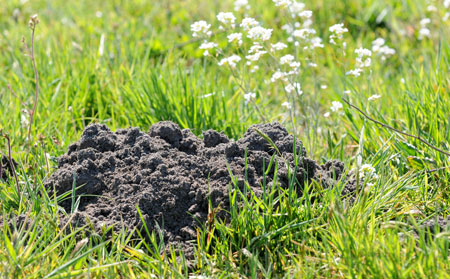|
|
MOLE REMOVAL
 Minnesota
has two
species of Moles, the Eastern Mole and the Star Nose Mole. Moles only
have one litter a year. They give birth to two to five young in late
spring. Moles are insectivores. A 5 ounce mole will consume 45-50 lbs
of worms and insects each year. These little dirt diggers can dig
surface tunnels at approximately 15 to 18 feet an hour and as much as
150-200 feet a day. Moles travel through existing tunnels at about 80
feet/minute. A mole's tunnel is an insect trap. As insects, larvae and
worms burrow through the ground, they often wind up in the mole's
tunnel. The mole patrols his tunnels and eats these unfortunate
critters. Moles eat only "live" food. They eat earthworms, insect
larvae and any ground dwelling insects. (That is why Juicy Fruit gum,
human hair, poison peanuts and other home remedies do not work, they
are not alive!) The mole simply follows the food. During the winter and
dry summers the mole will tunnel down to where the insects are, at
these times the homeowner sometimes gets a reprieve from the mole's
destructive surface activity. The life expectancy of a mole is
approximately 3 years due to its extremely high metabolic rate. Moles
are very territorial and won’t tolerate another mole in its
tunnel
system. The average lawn has between 1-3 moles. Minnesota
has two
species of Moles, the Eastern Mole and the Star Nose Mole. Moles only
have one litter a year. They give birth to two to five young in late
spring. Moles are insectivores. A 5 ounce mole will consume 45-50 lbs
of worms and insects each year. These little dirt diggers can dig
surface tunnels at approximately 15 to 18 feet an hour and as much as
150-200 feet a day. Moles travel through existing tunnels at about 80
feet/minute. A mole's tunnel is an insect trap. As insects, larvae and
worms burrow through the ground, they often wind up in the mole's
tunnel. The mole patrols his tunnels and eats these unfortunate
critters. Moles eat only "live" food. They eat earthworms, insect
larvae and any ground dwelling insects. (That is why Juicy Fruit gum,
human hair, poison peanuts and other home remedies do not work, they
are not alive!) The mole simply follows the food. During the winter and
dry summers the mole will tunnel down to where the insects are, at
these times the homeowner sometimes gets a reprieve from the mole's
destructive surface activity. The life expectancy of a mole is
approximately 3 years due to its extremely high metabolic rate. Moles
are very territorial and won’t tolerate another mole in its
tunnel
system. The average lawn has between 1-3 moles.
 Mole
Damage Mole
Damage
The mole pushes soil up and out of a vertical tunnel and creates a
volcano-like mound. These mounds can damage lawn mowers and makes
mowing your lawn a challenge. It also creates tunnels under
the
surface of the grass. This exposes the roots of the grass and kills it.
The moles tunnels are commonly used by other mammals like shrews,
voles, and mice and they are responsible for eating grains, seeds,
bulbs and other tubers.
Controlling
Nuisance Moles
Trapping is the most effective and practical method of mole control and
removal. In general, Nuisance Bat and Wildlife Control has greater success in
the spring and fall, especially after rain or in lawns that are watered
regularly. In the summer and winter, moles are active in deep soil and
more difficult to locate. Traps are set in active surface
burrows. NBWC has a plan to fit all property owners, the
regular
plan for 2 acres or less is a setup fee and a per mole charge (remember
the average yard has 1-3 moles). We have yearly contracts or we can
trap by the week or month. These are priced per site.
Or more information on Mole removal call 763-227-9888
|

